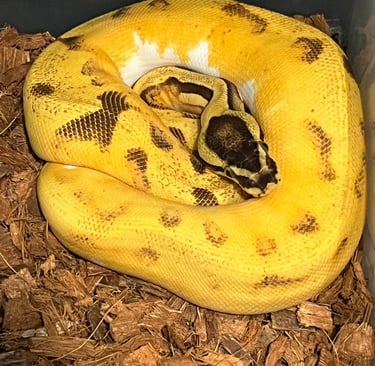Morphs for Beginners: What You Need to Know Before Picking Your First Snake
A beginner's guide to Ball Python Morphs
Emerald City Reptiles
7/29/20252 min read


Morphs for Beginners: What You Need to Know Before Picking Your First Snake
If you're just getting into reptiles—especially snakes—you've probably come across the word morph. It gets thrown around a lot in breeder listings, YouTube videos, and reptile expos. But what does it actually mean? And why should you care if you're new to the hobby?
Let’s break it down in plain English.
So... What’s a Morph?
A morph is basically a genetic variation that changes how a reptile looks. It can affect color, pattern, or even the texture of their scales. Morphs are super common in species like ball pythons, leopard geckos, and corn snakes. Breeders have spent years selectively pairing animals to create all kinds of wild and beautiful combinations.
Some morphs are bright yellow. Some are pure white. Some look like they came straight out of a sci-fi movie. It’s all genetics—and it’s fascinating stuff once you dive in.
Why Morphs Matter (Even If You’re Just Starting Out)
When you’re new to reptiles, it’s easy to get caught up in how cool a snake looks. But morphs aren’t just about aesthetics. They can actually affect things like:
Temperament – Some morphs tend to be calmer and easier to handle.
Feeding habits – Certain lines are more reliable eaters.
Health – A few morphs have known genetic issues you’ll want to avoid.
Price – Basic morphs are usually more affordable than rare combos.
So yeah, picking the right morph can make your first experience way smoother.
Good Starter Morphs for Ball Pythons
If you’re looking at ball pythons (which are awesome beginner snakes, by the way), here are a few morphs that are beginner-friendly and won’t break the bank:
Pastel – Brightens up the natural colors. Affordable and easy to find.
Albino – White and yellow with red eyes. Super striking and hardy.
Banana – Yellow blotches on a tan base. Friendly and popular.
Butter – Creamy yellow tones. Calm and visually appealing.
Mojave – High contrast darks and lights. Great for future breeding projects.
These morphs are generally easy to care for, have good temperaments, and are widely available from reputable breeders.
Basic Care Tips for Your First Morph
Once you’ve picked your snake, here’s what you’ll need to keep it happy:
Tank size: Start with a 20-gallon for juveniles. Adults need 40 gallons or more.
Temps: Basking spot around 90°F, cool side around 78°F.
Humidity: Keep it between 55–60%. Boost to 70% during shedding.
Feeding: Frozen-thawed mice or rats once a week. Match prey size to the snake’s girth.
Handling: Go slow at first. Avoid handling right after feeding or during shedding.
A Few Things I Wish I Knew Starting Out
Don’t buy based on looks alone. Ask about feeding history and temperament.
Some morphs (like spider) have known neurological issues. Do your homework.
Reptile forums and Facebook groups can be goldmines for advice—but take everything with a grain of salt.
Keep a log of feedings, sheds, and behavior. It helps you spot issues early.
Final Thoughts
Morphs are one of the coolest parts of reptile keeping. They let you choose a snake that fits your style, your budget, and your experience level. But they’re also a reminder that these animals aren’t just decorations—they’re living creatures with unique needs.
If you’re just starting out, stick with a beginner-friendly morph from a breeder who knows their stuff. Ask questions. Learn the basics. And enjoy the ride—because once you get into morphs, it’s hard to stop at just one.
#BallPythonGenetics #ReptileBreeding #EmeraldCityReptiles #BallPythons #KnowYourMorphs #SnakeBreedingBasics
Blog / Ball Pythons
Explore our insights on ball python breeding.
CONTACT
Sign Up for Updates no spam
info@ecreptiles.com
© 2025. Emerald City Reptiles All rights reserved.


